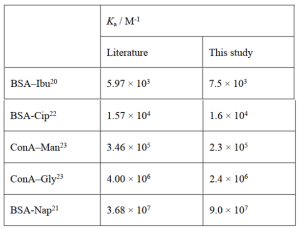Advantages
- Semi-quantitative determination of equilibrium constants using particle dissociation behavior in a combined ultrasound-gravity field
- Solves the problems of long measurement time and amount of sample required by the LSPR and QCM methods, and does not require special equipment or techniques to measure equilibrium constant
- Equilibrium constants from 102 M-1 to 109 M-1can be measured
- Demonstrated semi-quantitative determination of protein-ligand equilibrium constants
Background & Technology
The interaction force between molecules is an important parameter in the evaluation of drug specificity and particle function, and has been measured by the LSPR (Localized Surface Plasmon Resonance) method and QCM (Quartz Crystal Microbalance) method, but measurement of weak interactions is difficult because of the long time required for measurement and the large amount of sample required.
Dr. Miyagawa and his colleagues at the University of Tsukuba have created a method for semi-quantitative determination of equilibrium constants with a very small amount of sample in a chemical reaction system with small equilibrium constants, based on the voltage at which particle dissociation occurs (ultrasonic radiation force) and intermolecular force (equilibrium constant), using the particle dissociation behavior in a combined ultrasound-gravity field.
Experimental data are shown in the table below (taken from Analyst, 2022,147, 4735-4738). We demonstrated close agreement with literature values in the semi-quantitative determination of protein-ligand equilibrium constants (errors of about 2-3-fold). The detectable range is the equilibrium constant Ka = 102-109 M-1.
 |
The analyzer using this invention enables measurement of the divergence constant of molecular complexes in a short time, and discrimination of multiple bonds in contaminants. This is expected to be applied in various fields such as drug discovery and functional materials.
Researcher
Akihisa Miyagawa : University of Tsukuba Assistant professor
Patent & Publication
・Patent pending, PCT application to be filed.
・Paper:Analyst, 2022,147, 4735-4738
Expectation
The University of Tsukuba is seeking partner companies to develop analyzers using this technology.
Project No: DA-04189


